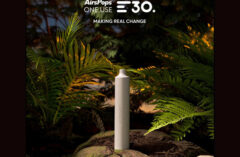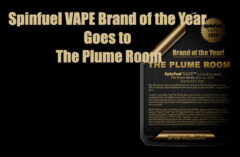Table of Contents
Last Updated on February 10, 2016 by
Diacetyl – A word from the publisher
The decision to publicly respond to Mountain Oak Vapors Facebook post about trace elements of Diacetyl being discovered in a handful of their eLiquids began after we started receiving emails from Vapers that follow our Facebook page. Everyone that took the time to email us wanted to know what “we” thought about the post, and if we believe there is any culpability.
One Spinfuel reader, Cathy, sent us an email that was then forwarded along to me. The email, in part, read: “This concerns me because I recently purchased, and received, a bottle of the Chai Tea Latte which garnered one of your Spinfuel Choice Awards. Although this juice is absolutely phenomenal, the Diacetyl aspect, and the fact they did not disclose this sooner, raises a red flag to me.”
I know Mountain Oak Vapors acted with lightening speed when they discovered that one of the flavorings in their flavor arsenal carried trace elements of Diacetyl.
There was no way for them to “disclose this sooner”, since they acted as soon as the reports came in from the chemist.
As for me, the publisher of Spinfuel eMagazine, I was delighted that Mountain Oak Vapor took swift and decisive action as soon as they did, but I also believe that much of the vape community may have overreacted to Diacetyl in eLiquid or eShisha over the years. Like you, I wanted to find out.
So, I looked to John Castle, our managing editor, and asked him to look deeply into the latest information that is available about Diacetyl and how it ‘may’ affect Vaping and what the effects of Diacetyl could be on Vapers, and to what, if any, degree.
Below is his report. I hope you read it. If you have questions or concerns about what you will read below, please let us know. Use the comment system and sound off. Let’s not run and hide from the truth, let’s embrace it, let’s demystify it, and once and for all, figure out if there is any ‘there’ there. – John Manzione – Publisher
Diacetyl- Risks, Prevalence, and Precautions
It recently came to light for an eLiquid manufacturer that some of their liquids were tainted with a substance known as Diacetyl. The reason why this is important — and the reason why their quick response to it, as well as their open and frank notification of their users of it, is the purpose of this article.
On January 3rd, Mountain Oak Vapors released the following announcement:
“During a recent clinical study of one of our E-Liquids it has been brought to our attention that one of our Caramel Flavorings MAY contain Diacetyl. Diacetyl (a common ingredient in buttery/custard flavors) has been known to cause damage to the lungs from sustained and prolonged inhalation. While we use many different ingredients from many different suppliers across the USA, it has always been our goal to make sure each and every recipe is DIACETYL FREE. This error falls on us, as we failed to realize Caramel could be the culprit for an ingredient such as this.
As a company, we have always been open and honest about everything. So at this time we’d like to issue a general warning announcement. While all of these E-Liquids were not tested, they do share the same Caramel flavoring as the E-Liquid that was tested.
FULL VIRGINIA FLAKE RY4
CHAI TEA LATTE
CARAMELA
GAMBLER
If you currently have any of these bottles and are not comfortable with vaping them, you may return them to Mountain Oak Vapors for an exchange. Please email [email protected] to arrange this, or if you’re local just stop by any of our business locations.
For now, we are working to source an alternative ingredient of equal caliber as a suitable replacement for the caramel used in these recipes. We expect the process to take around 3-4 weeks. In the interim, we have temporarily suspended the sale of these 4 flavors. As soon as it is possible that we can bring these flavors back, we will.
If you have any further questions in regards to this matter you may email them to: Administrator AT mountainoakvapors.com”
But the big question I had, and which I suspect many readers will have is: What is Diacetyl? Why the suspension of sales?
What is Diacetyl, and what are the risks of Diacetyl inhalation?
To find out what Diacetyl is, and the potential health risks of inhaling it is I consulted as many sources as I could find. The first I found was, I will readily admit, more than a little alarming.
To begin with, Diacetyl is a naturally occurring compound formed through the reaction of fermentation. It is generally present in some alcoholic beverages, such as various wines, as a natural consequence of the fermentation process; however, in most wines, it is reabsorbed by the yeasts that initially form it.
It’s also used extensively in butters and margarines and is the compound that gives them their characteristic flavor. When you taste something you would describe as, “buttery”, what you’re actually describing is the flavor of Diacetyl.
However, it’s also used in a variety of other foodstuffs in order to lend them a butter, butterscotch or, and this is the bit that should be of particular importance to Vapers, the part where Mountain Oak Vapors’ discovery comes in, a caramel flavor.
Now, ordinarily, the consumer would never face the risks of inhalation of Diacetyl; by the time you purchase anything containing this substances — say a package of microwave popcorn — the compound is saturated in the foodstuff you’re about to consume.
However, according to the Occupational Safety & Health Administration, Diacetyl when inhaled can, in rare cases, present health risks to the respiratory system of some mammals, including humans.
Quoting from the OSHA “Hazard Communication Guidance for Diacetyl and Food Flavorings Containing Diacetyl (Which you can read in full at this link A number of employees exposed to FFCD have developed serious respiratory illness presenting with persistent dry cough, wheezing, shortness of breath upon exertion, and fixed airways obstruction on spirometry. Several employees have been diagnosed with asthma or bronchiolitis obliterans. Bronchiolitis obliterans occurs when small airways become inflamed and scarred, resulting in the thickening and narrowing of the airways. The symptoms and airways obstruction range from mild to severe, and do not improve when the employee goes home or on vacation. Because bronchiolitis obliterans is a rare disease, some employees may have been potentially misdiagnosed with asthma, bronchitis, emphysema, and/or pneumonia. The loss of pulmonary function associated with severe bronchiolitis obliterans is permanent and some patients have been placed on lung transplant waiting lists. The National Institute for Occupational Safety and Health (NIOSH) has, and continues to investigate, the occurrence of severe lung disease in employees at microwave popcorn packaging plants (NIOSH, 2003) and flavorings manufacturing facilities (Kanwal and Kullman, 2007). NIOSH reported that medical tests of employees at microwave popcorn plants showed fixed airways obstruction, some cases consistent with bronchiolitis obliterans, and other respiratory illnesses such as occupational asthma. NIOSH concluded that the lung diseases identified in these microwave popcorn plant employees were likely due to exposure to butter flavoring chemicals (NIOSH, 2003; Kanwal, et al., 2006). NIOSH also described cases of fixed airways obstruction, including three cases consistent with bronchiolitis obliterans, among employees producing butter and vanilla flavorings containing Diacetyl at a flavorings manufacturing facility (Kanwal and Kullman, 2007). NIOSH concluded that, in this facility, “[i]t is highly likely that exposures to Diacetyl contributed to the occurrence of severe fixed obstructive lung disease…”, but that the role of other flavoring chemicals was unknown (Kanwal and Kullman, 2007). NIOSH also reported that employees at microwave popcorn plants and a flavorings manufacturing facility experienced eye, nasal, and/or upper respiratory irritation and/or burns (NIOSH, 2003; Kanwal and Kullman, 2007). In some cases, skin and eye burns have required medical treatment. For more information about specific NIOSH Health Hazard Evaluations (HHE) regarding these chemicals, see http://www.cdc.gov/niosh/homepage.html. Recent studies have shown respiratory tract damage and death among rodents exposed to Diacetyl and butter flavorings containing Diacetyl. Hubbs and co-investigators demonstrated in a preliminary study that exposure of rats to 198.4 ppm of Diacetyl for 6 hours caused necrosis of the nasal and tracheal epithelium (Hubbs, et al., 2004). In another preliminary study, exposure of mice to 200 and 400 ppm Diacetyl via inhalation for 6 hours per day over 5 days caused death, acute necrotizing rhinitis, and erosive or necrotizing laryngitis (Morgan, 2006). This same study also showed exposure of mice to 200 and 400 milligrams per kilogram (mg/kg) Diacetyl via oropharyngeal aspiration caused bronchiolar fibrosis and death. Recent inhalation studies have demonstrated that exposure of rats to butter flavoring vapors containing high concentrations of Diacetyl (300 ppm) caused epithelial injury in the nasal passages and pulmonary airways (Hubbs, et al., 2002) Now, there are a few things I would like you to understand about my perspective on what you just read. First, the preceding deals with inhalation of the raw compound, undiluted. The potential risk you would face on inhaling a vapor containing comparatively minimal traces of this compound in eLiquid vapor form are, let me hedge my bets here, likely to be… well… comparatively minimal. Second, we don’t know, at the time of this writing, at what concentrations this compound was found in the affected eLiquids. Finally, what we do know, at the time of this writing, both from Mountain Oak Vapors’ public statement and from my communications with Steve Nair at Mountain Oak Vapors is that no presence of this compound in the affected eLiquids is acceptable to MOV. Regardless of how minimal the risk is, they do not consider any level of risk to be acceptable. I’ll touch on that fact once more in the conclusion. For now, let’s move on to how the infiltration of Diacetyl is likely to occur. So how could Diacetyl find its way into eLiquids? The first and most immediate route I can logically imagine is most likely that ingredient suppliers are still not quite considering all of the possible applications of their ingredients. For them, what might be a perfectly acceptable flavor additive is simply not given the proper amount of thought for the flavor additive’s uses — and so they omit vital chemical components from its list of ingredients. After all, if you bake a chocolate cake, would you expect someone to find a way to vaporize it and inhale the vapor? Of course not. So why bother to mention all the ingredients? At the same time, if you buy a flavoring extract with the intent to use it in eLiquid, and all of the listed ingredients are safe, and your laboratory testing of those ingredients indicates that they’re likewise safe, you would be hard pressed not to be surprised by later, higher-resolution tests that reveal trace amounts of an unexpected component of that flavor — a component that the seller of the flavoring never listed, and one which earlier tests never revealed. But here’s where the vaping industry, and particularly Mountain Oak Vapors, have distinguished themselves for the better: While tobacco companies, foodstuffs manufacturers, and others would simply continue to sell incredibly profitable products even after knowing about the presence of undesirable or risky elements in their ingredients lists, this industry holds itself to a higher standard. And this company, Mountain Oak Vapors, has placed itself firmly at the forefront of leadership on that higher standard. I have come to know, personally, several eLiquid manufacturers, and know many more through online communication. I’ve come to expect a higher ethical standard from this industry, based on my interactions with them, but even I was surprised, for the better, with this action on the part of Mountain Oak Vapors. They determined, independently, that one of their flavoring extracts was exposing their customers to an unknown but logically minimal level of risk — not only did they take immediate action to remove that risk from their customers’ experience, but going above and beyond (by the standards of most businesses’ ethics) they openly and voluntarily notified their customers and potential customers of the risk and of their swift corrective response to it. I corresponded with Mountain Oak Vapors’ Steve Nair regarding the issue and he had this to say: “Diacetyl is not a new topic, Vapers and vendors have known about this for years, although it isn’t really talked about very much, and sometimes if it is talked about it’s not taken as a very serious threat. A lot of vendors state they do not use it (just like we did), but what are we doing to make sure we’re not using it? Up until now we just asked our suppliers and took their word for it. Unfortunately this is also what 90% of everyone else has done as well. We have to take it a bit more seriously than that and we are taking it more seriously now. In the end we are Vapers ourselves and avid fans of our own products. Gambler & Caramela are two of my personal favorites… I have as much in it as any one of our customers and if folks are angry with us we have to accept that and understand our responsibilities. We just hope most can appreciate us for doing the right thing and going above and beyond with our testing, and indeed that has been the general response we have received from this. Self-regulation that is what it’s all about. Regulating ourselves and doing the right and responsible things before the FDA has to do it for us (they will anyways.).” To me, this issue has raised an important issue that we, as Vapers, should all be cognizant of — and thankful for, and hopeful because of. Because this industry, as exemplified in amazing fashion by Mountain Oak Vapors, is one of people who use their own products. You never trust the chef who won’t eat his own cooking, but the corollary to that — and this incident stands as evidence of the corollary — is that you can trust the mixologists who vape their own liquids. More importantly, the mixologists who care enough about the quality and safety of their eLiquids to have them independently and expertly tested for quality assurance purposes and who, if anything comes to light that could even possibly put we, their customers, at risk, will forego profits in favor of doing the right thing. This was my initial response to Mountain Oak Vapors’ public statement, and I think I’ll wrap up with it: “The [public statement] from Mountain Oak Vapors is one of the biggest reasons why eLiquid companies, especially this one, are far and away more ethical than tobacco companies. The tobacco companies put dangerous elements into tobacco *on purpose*. MOV has their liquids tested and, if something risky is found in them, they actually *suspend the sale of the risky eLiquid* — not only do they do that, they go out of their way to keep their customers and potential customers informed. Major kudos to Mountain Oak Vapors for their sound ethics and good business sense. Thank you, guys. John CastleHow does Diacetyl find its way into eLiquids?
What does it say about the vaping industry that this compound was found in eLiquids?
Conclusion








